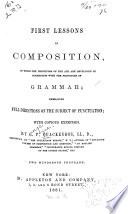 | James Greenwood - English language - 1753 - 376 pages
...ftri&ly relate to the Qrtbograpfy, er Writing of A Hypbtn, which is nfed at the End of a Line, whe n there is not Room for all the Word, but one or more...be written at the Beginning of the next Line: The Mark is a ftraight Line thus {-). It is alfo ufed in the compounding or joining two Words into one... | |
 | George Fulton - English language - 1826 - 224 pages
...Sheridan, or a Walker, to answer this question. If the object of division be, to take in part of a word at the end of a line when there is not room for the whole, I would divide them thus, — Busi-ness, colo-nel, vict-uals, without finding fault with... | |
 | George Payn Quackenbos - English language - 1857 - 206 pages
...To connect two simple words that unite to ibn^ i compound word ; as, " A spirit-moving strain." IL At the end of a line, when there is not room for the whole of a word, the hyphen is placed after one of its syllables, to show that the remainder may... | |
 | George Payn Quackenbos - English language - 1858 - 204 pages
...To connect two simple words that unite to form ft compound word; as, "A spirit-moving strain." II. At the end of a line, when there is not room for the whole of a word, the hyphen is placed after one of its syllables, to show that the remainder may... | |
 | George Payn Quackenbos - English language - 1862 - 204 pages
...To connect two simple words that unite to form a compound word ; as, " A spirit-moving strain." II. At the end of a line, when there is not room for the whole of a word, the hyphen is placed after one of its syllables, to show that the remainder may... | |
 | George Payn Quackenbos - English language - 1868 - 204 pages
...To connect two simple words that unite to form a compound word ; as, " A spirit-moving strain." II. At the end of a line, when there is not room for the whole of a word, the hyphen is placed after one of its syllables, to show that the remainder may... | |
 | George Payn Quackenbos - English language - 1871 - 198 pages
...To connect two simple words that unite to form a compound word ; as, " A spirit-moving strain". II. At the end of a line, when there is not room for the whole of a word, the hyphen is placed after one of its syllables, to show that the remainder may... | |
 | George Payn Quackenbos - English language - 1881 - 210 pages
...To connect two simple words that unite to form a compound word; as, " A spirit-moving strain". II. At the end of a line, when there is not room for the whole of a word, the hyphen is placed after one of its syllables, to show that the remainder may... | |
 | Charles De Garmo - English language - 1897 - 226 pages
...right. No margin is required on the right-hand side of the page. 4. A syllable should never be broken at the end of a line. When there is not room for the whole of the last word on the line, write as many syllables as possible, and place a hyphen after... | |
 | Marcelia McKeon - English language - 1904 - 208 pages
...joins two or more words and makes them into one. The hyphen is written after a syllable or syllables at the end of a line, when there is not room for the whole word. 7. WRITTEN EXERCISE. Write a sentence on one of the following subjects. Caution. —... | |
| |